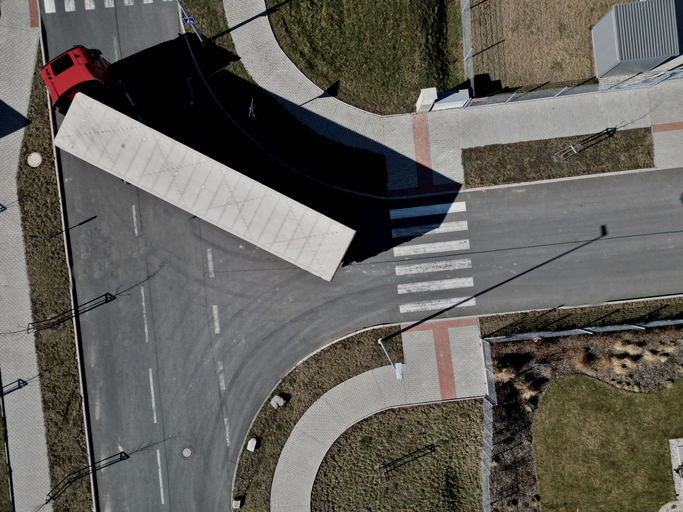A truck’s no-zone refers to the dangerous blind spots around large commercial vehicles, where passenger cars disappear from the truck driver’s view. Understanding what a truck’s no-zone is can be the difference between a safe trip and a serious truck accident on Jacksonville’s busy highways. These blind spots are much larger than those found on regular cars. They create hidden dangers for drivers who share the road with 18-wheelers and other commercial trucks.
Understanding Blind Spots Around Large Trucks
Commercial trucks have four main no-zones that create serious safety hazards for other motorists. These areas exist because of the truck’s size, height, and mirror placement on the cab.
Several factors create these blind spots:
- The high position of the truck driver’s seat
- The large length and width of trailers
- Limited mirror coverage around the vehicle
- Physical blocks created by the truck’s structure
Unlike passenger vehicles, trucks cannot get rid of these blind spots entirely. Even with properly adjusted mirrors, the physics of large vehicles makes these blind spots unavoidable.
Front No-Zone Dangers
The area directly in front of a truck creates a significant blind spot many drivers underestimate. This zone extends about 20 feet from the front bumper, making it impossible for truck drivers to see vehicles that cut in too closely.
Cars that merge into this space put themselves at extreme risk. If the car needs to brake suddenly, the truck driver may not see the vehicle in time to avoid a collision. The massive weight difference between trucks and cars makes these collisions particularly devastating.
Keeping a proper following distance is equally important when driving behind trucks. The elevated cab position means truck drivers cannot see cars following too closely in their rear no-zone.
Side No-Zone Hazards
The side no-zones present the most complex challenges for passenger vehicle drivers. The right side blind spot is particularly dangerous because it spans the entire trailer length and extends into adjacent lanes.
Many serious accidents occur when cars travel alongside trucks for long periods. Drivers may feel safe because they can see the truck, but the truck driver cannot see them. This false sense of security leads to dangerous situations during lane changes.
The left no-zone is smaller than the right, but still covers a significant amount of road space. A Federal Motor Carrier Safety Administration study shows that vehicles staying in these blind spots often result in side-impact collisions with trucks.
Rear No-Zone Considerations
The rear blind spot extends much farther behind trucks than most drivers realize. This 30-foot zone makes it impossible for truck drivers to see following vehicles that are too close.
Following trucks too closely is extremely dangerous for multiple reasons. The elevated position of the truck driver creates a blind spot that can hide entire passenger vehicles. Also, trucks require much longer stopping distances than cars due to their weight and momentum.
Smart drivers maintain a following distance of at least four seconds behind trucks. This spacing ensures visibility and provides adequate reaction time if the truck needs to stop suddenly.
How to Stay Safe Around Trucks
Avoiding no-zones requires strategic driving and constant awareness of truck positions. Successful defensive driving around trucks involves multiple safety practices.
Essential safety strategies include:
- Position your vehicle where the truck driver can see you in the mirrors
- Pass trucks quickly to minimize blind spot exposure
- Keep at least a four-second following distance behind trucks
- Signal early when changing lanes near commercial vehicles
- Avoid sudden movements or lane changes around trucks
- Never stay alongside trucks for long periods
Remember the basic rule: if you cannot see the truck driver in their side mirror, they cannot see you. This simple guideline helps drivers avoid dangerous blind spots.
Truck Technology and No-Zone Awareness
Modern semi-trucks are increasingly equipped with advanced safety systems to reduce accidents in blind spots. Blind spot monitoring systems alert truck drivers when vehicles enter their blind spots. However, these systems are imperfect and cannot replace defensive driving by passenger vehicle operators.
Some trucks now include additional mirrors, cameras, and warning systems. While these technologies help, they do not eliminate the basic physics that creates blind spots around large vehicles.
Passenger vehicle drivers should not rely solely on truck technology for their safety. Understanding and avoiding no-zones remains the most effective protection from truck accidents.
Legal Responsibility and the Importance of Documentation
While truck drivers have responsibilities to drive safely, passenger vehicle drivers also have duties to avoid creating dangerous situations. Understanding these legal principles emphasizes the importance of defensive driving around trucks.
Documentation becomes crucial in no-zone truck accidents. Police reports, witness statements, and physical evidence help establish what happened and why. Proper legal representation is essential for protecting rights and ensuring fair treatment after truck accidents.
Contact the Jacksonville Truck Accident Lawyers at The Truck Accident Law Firm for Help Today
If you have been injured by someone else’s negligence, we’re here to help. Contact our Jacksonville truck accident lawyers at The Truck Accident Law Firm for a free consultation today.





